
Top: one of author’s favorites, Olaes Modular Bandage from Tactical Medical Solutions in four-inch version. Bottom: four-inch wide Israeli bandage. Note how they are packaged and able to be stored in a range bag, not just on a shelf in a hospital closet. Photo: author
“Improvised” Tactical Medicine
The word “improvised” gets thrown around in the field/tactical medical industry more than I want to acknowledge. Yes, in the field and in a clinical setting, we healthcare professionals do on occasion have to improvise a little in order to make things work regarding patient care and treatment. When I was a combat medic, improvisation was not only encouraged, but we also were tested on it several times throughout our training at Ft. Sam Houston. One thing we learned as new medics in the Army was that if we can’t get more than three uses out of one object/item/device/piece of equipment, we didn’t carry it. A handful of tongue depressors were not used just for looking down someone’s throat. They were also finger splints, a windlass for a tourniquet, puppets for keeping kids occupied during transport, and you could even use them to help organize your M5 Aid Bag. A bomb tech once showed me a cool trick using a tongue depressor broken in half to make part of a trip fuse. My point is that sometimes we may have to use a little ingenuity to save a life or two. But that doesn’t mean we should be trying to re-invent the wheel!

Viewing both bandages opened, it’s easy to see that these dressings are designed specifically to control moderate to severe bleeding in the field.
Photo: author

But for the record — blood-letting was a good idea back in the day too. Just because something worked once doesn’t mean it will work again. We’ve got over 12 years of “well, that didn’t work — let’s try something else” to learn from. The technology that has developed far superior products now available to healthcare providers and the layperson alike is unprecedented today.
In regard to choosing a product that controls major bleeding, plenty of bandages have evolved from the old few rolls of Kurlex gauze and a six-inch ACE wrap, to what is now considered an actual “pressure bandage/dressing.” Companies like Tactical Medical Solutions, QuikClot, Celox, H&H, SAM Medical and others have produced some of the most advanced, effective, and efficient bandages and dressings for the treatment of penetrating traumatic injuries in the field and tactical medical industry. Yet for some reason, people still feel the need to treat patients like they are living in some bad Mad Max remake. The pressure dressings designed by the companies I just mentioned are specifically designed for moderate to severe arterial bleeding and packaged for austere environments.
What Is a Tampon Designed For?
A tampon is designed to be inserted into the vagina of a female human being in order to absorb menstrual fluids, which are discharged over the course of a few days. The discharged fluid is made up of about 40-50% actual blood, and then several other types of tissues, such as uterus lining, broken-down unfertilized eggs, some hormones, and maybe even small amounts of vaginal secretions. This fluid is not pressurized like arterial blood is throughout the body. Nor are these menstrual fluids needed to sustain life to other organs of the human body, for example the brain.
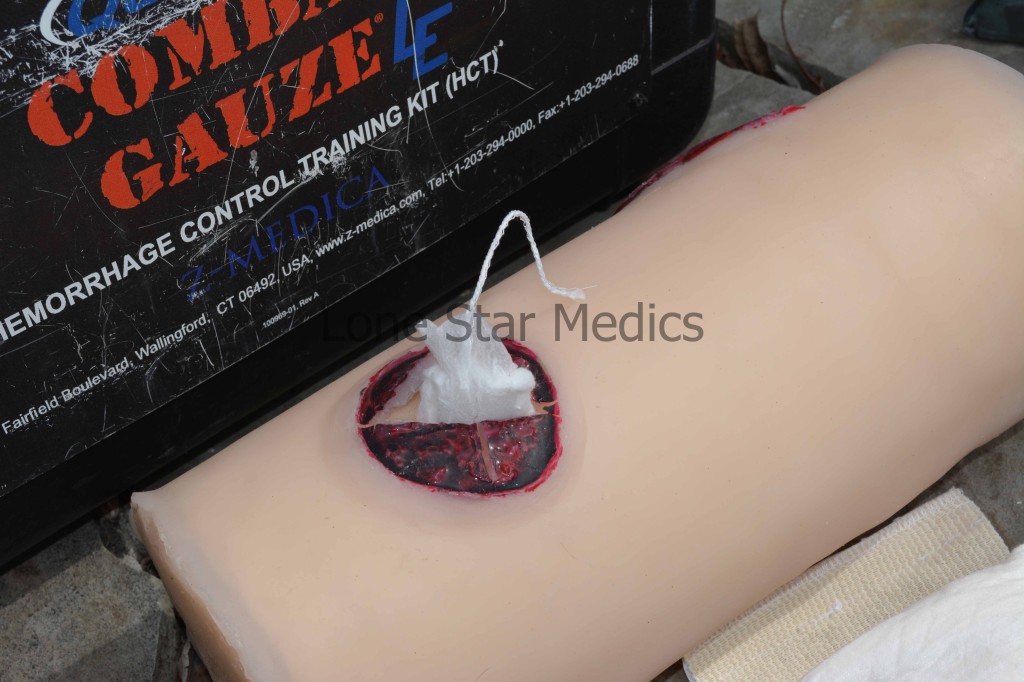
When using a wound packing simulator from QuikClot; it is obvious that a tampon doesn’t come close to filling a ballistic wound cavity.
Photo: author
Bleeding from a Gunshot Wound
Now let’s talk about the type of bleeding one might come across from a single gunshot wound. Arterial blood is made up of oxygen-rich pressurized blood that transports minerals, vitamins, nutrients, and all sorts of other good stuff the body and its organs need in order to function. The brain requires several of these things in order to keep the rest of the body alive. This is why we assess and treat injuries in the order of Circulation, Airway, Breathing (CAB). But that’s another article for another time. The point is that we have to control the bleeding first, in order to ensure blood circulation. That way the brain can continue working and keep the rest of the body going — which is what we’re after here.
Modern-day pressure dressings are in fact designed to treat penetrating traumatic injuries related to austere or combat environments. They are designed from the ground up to control moderate to severe bleeding, including pressurized arterial bleeding. Pressure dressings like the Olaes from Tactical Medical Solutions are packaged for field-like environments. Most manufacturers use gamma irradiation to sterilize their pressure dressings. Yes, we fight for life now and treat infection later. But consider that in order to properly control bleeding from some injuries, you may have to pack a wound with that bandage in the field.

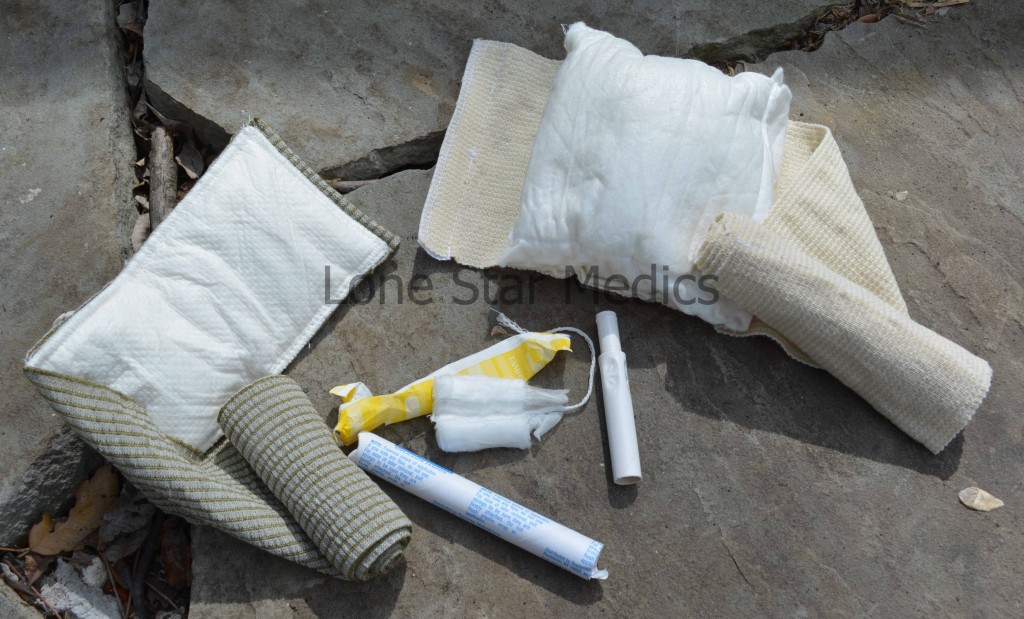
Which of these three products do you want to use to save your life or your loved one’s life? Photo: author
If cost is a concern, it shouldn’t be. You can buy two Olaes bandages for under $15, and two Israeli bandages for under $10. These aren’t going to break anyone’s bank account. They do come with expiration dates, but some last up to four years. For maximum shelf life, store the bandages in a med kit where the outer wrapping won’t be compromised.
Do yourself and your loved ones a favor: buy a real pressure dressing and take a class on how to use it effectively and efficiently. If you’re going to be carrying one or the other as part of your EDC kit, don’t plan to improvise … plan to win!

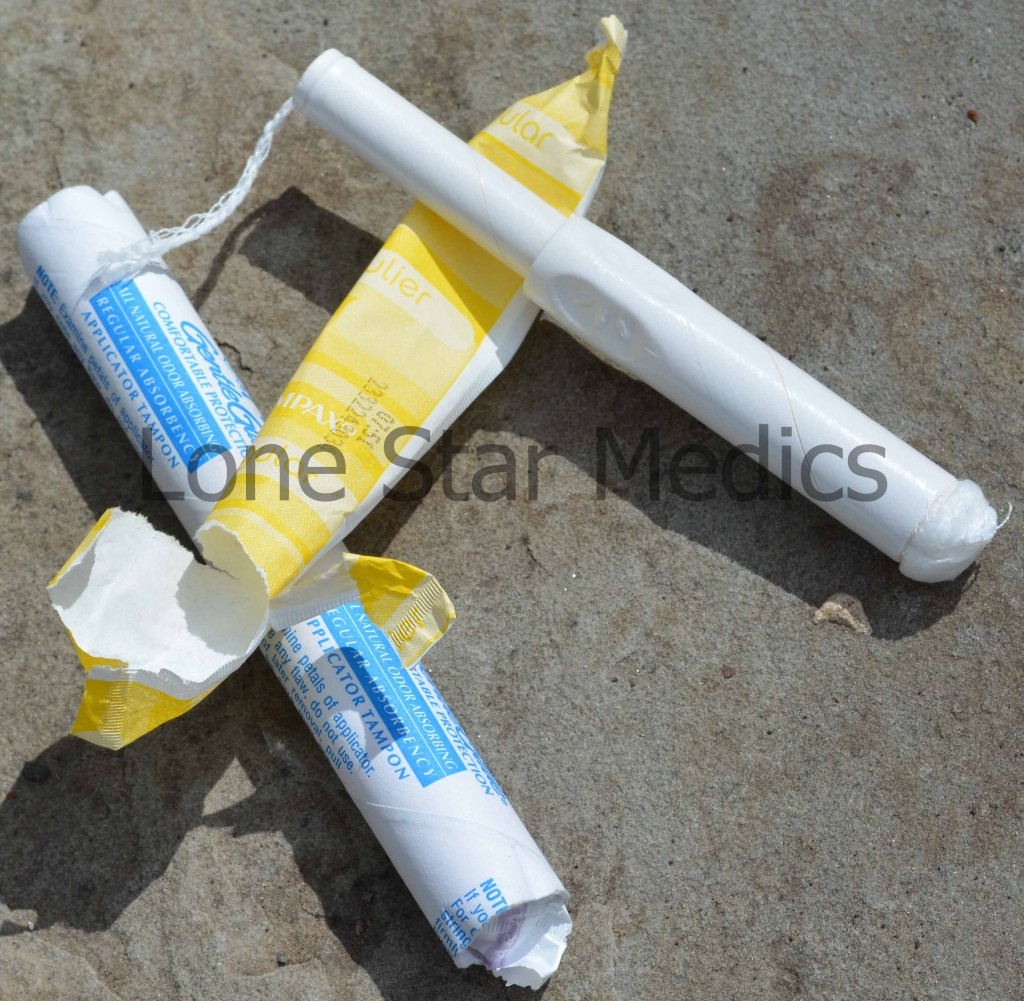
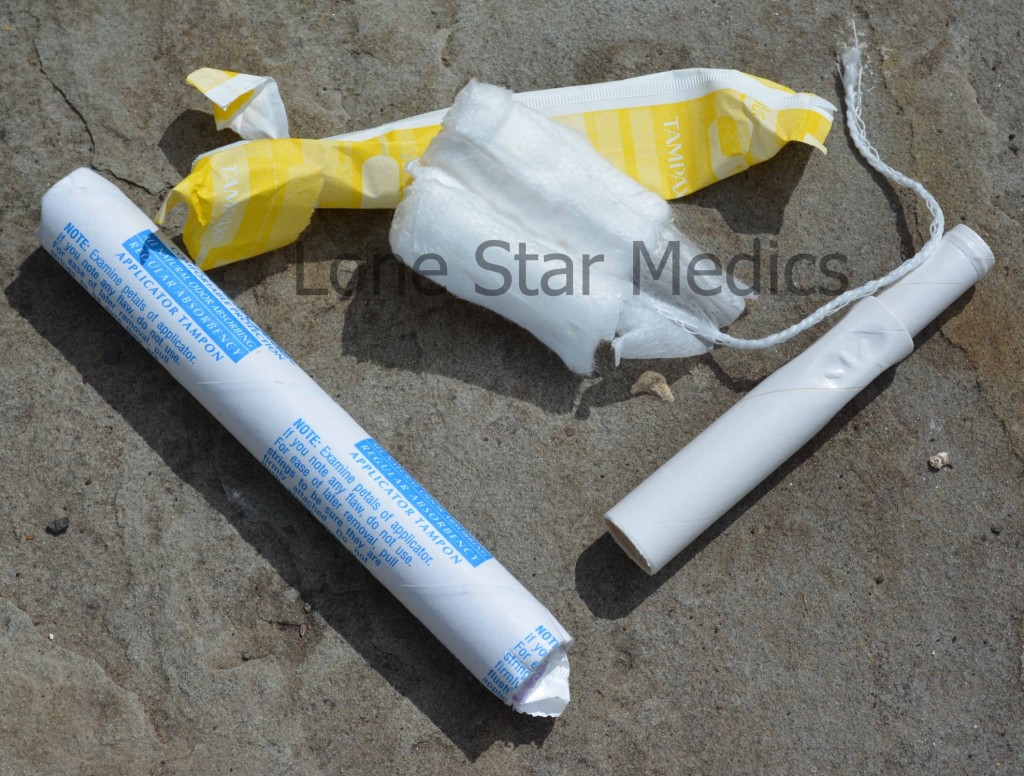
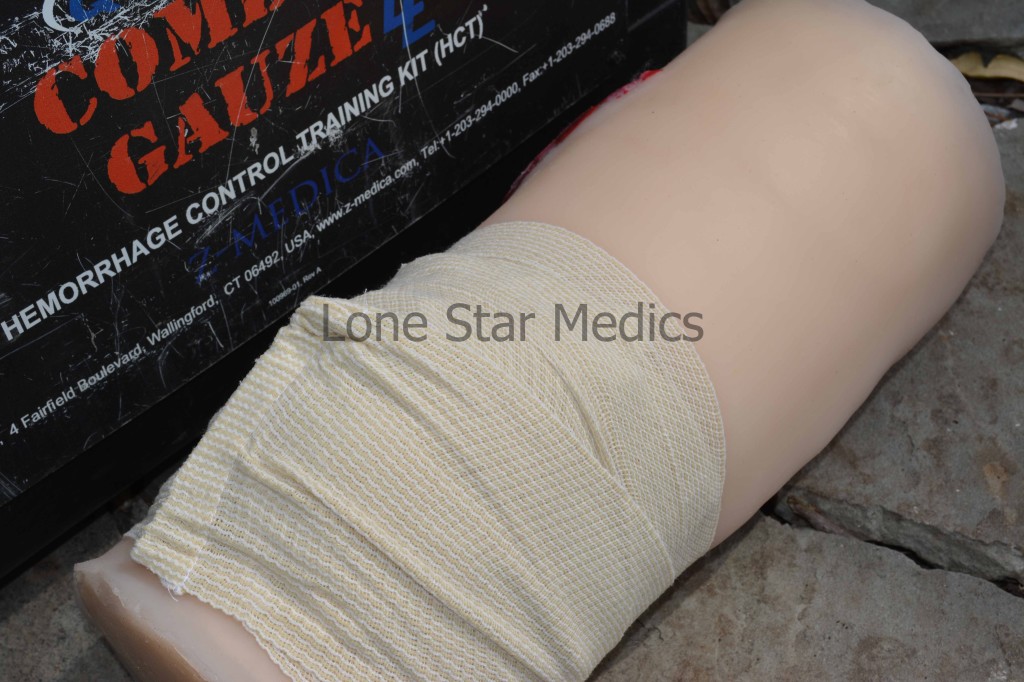
As a former nurse LPN I have to agree with a lot of what this article said. While I would have cause for pause, in a situation where someone is about to DIE from massive bleeding. AND, miles away from the nearest hospital? You're dang right, I'm gonna use whatever absorbent reasonably clean items I have on hand to help stop OR slow down the rate of blood loss!! BUT! No a tampon or a small pad is not the greatest thing for preventing an infection long-term.I'm now retired from the medical field. And I USE too provide EMT service in my brother's hunting camps in the high mountain country of New Mexico and Colorado. OUT there? Where you're anywhere from 5-8-even 10 miles away from the nearest forestry department roads?. Let alone the extra 20-50 miles to the nearest hospital? You'll do just about anything to help stop bleeding from a potential stray bullet wound! OR even a bad cut from a hunter that accidentally slit his hand while field dressing a deer or elk!! OR, like the camp cook that was prepping food in the dining and cook's tent! NEARLY SLICING OFF his thumb! Cutting up potatoes for a pot of stew. The base camp was 12 miles from the nearest forestry department road! The nearest hospital? It was nearly 50 miles away! SO while I had as much available medical supplies on hand as I could possibly pack into the backcountry. NOTHING BUT nothing is as good as the ER Department to save a life from a potential Sepsis infection from a knife or bullet wound! YOU have to USE whatever is immediately available before someone begins to bleed out and die in the backcountry! It's not as bad IF you have to give emergency first aid to someone in a major auto accident,but still miles and minutes away from dying? BECAUSE hopefully a local hospital will be able too call for a medical aviation unit ( essentially a Medevac helicopter 🚁), OR Air Medical Flite helicopter to transport an individual too the nearest hospital trauma center! BUT?, Still I think using whatever works best in a situation like that? Is better than nothing at all. Ask ANY Army OR Navy combat medic ABOUT the critical importance of the "Golden Hour"?)!! Infection CONTROL measures are important, but that can be done after the injured HAVE been treated for severe blood loss!😟 I ONCE did my time as a triage medic in a field hospital unit during the Vietnam Era! I'm still haunted by the memories of seeing one Medevac helicopter after another land at the nearest pads for our ambulances to go out and meet the choppers.
As a registered nurse who has done extensive wound care. I would use a tampon and or sanitary pad in a gsw if that's all that was available. Even though they are not sterile dressings they are clean. A gsw is already a dirty wound and unless you are masked up and donning sterile gloves while using sterile technique you are still introducing bacteria into the wound. Sterile technique is not what you're able to provide in a trauma situation at best you're providing aseptic technique which is good enough. What's most important is to stop or slow the bleeding.
I think the whole idea of tampons as a blood loss stop came from the bandage carried in the "first aid kit" in WWII. That "first aid kit" was a sulfa impregnated green pad about the size of a kotex pad with a gauze strip on either end to tie the pad in place. That was the extent of the IFAK for WWII and Korea. It was issued to every Marine as part of his 782 gear. It strongly resembled a green kotex and I would guess that they probably were made up in a factory that originally or mainly manufactured women's sanitary napkins. The big difference was they were impregnated with sulfa powder to prevent or inhibit infection. In WWII, that was the battlefield antibiotic of choice. You might get penicillin back in the division hospital, but in the foxholes and ditches it was sulfa powder. The corpsmen spread it over burns and wounds equally. It was the big difference between getting wounded in WWI and getting wounded in WWII.
If you sustained one or several gunshot wounds from a small firearm (not a rifle) and was left to save your life by yourself (since in todays world no one would do that for you), would would you do? But, please be real.I personally carry the largest tampons I found here in Europe, and I would stick those inside my wounds - I'm sure that'd be the maximum I would be capable of ...
You cover the tub tampons but NOT the Pads. I had a double shooting at my Grocery store While it would have taken about 2-3 min response time for help they could have bled out. If I had been there my first reaction to render aid would be grab gloves, duct tape, scissors & thick pads as well as peroxide. if I had time I would have grabbed off the shelf diagnostics like BP meters do to it being a shooting chances are the Ambo would be in a staging area till the cops could clear the scene. Providing first aid to victims till they could be treated by the Paramedics should take priority. Getting as much medical info to the paramedics would also hasten medical response. beyond taping a tampon pad on the victim I'm not qualified to do much else.
This info was helpful thanks.
Seen first hand of a tampon being used in a gunshot wound. It was Nov 2004,in Fallujah Iraq. The bullet entered the inner elbow and exit the back. The entry was packed with.... A tampon. The exit a gaze. Granted the artery was not hit. There was no need for additional care other than a bandage wrap. What people on this comment section fail to understand is that the author is talking about bleeding involving the artery. There's three types of bleeding and a tampon can help with 2 of those. Bleeding stops by pressure in most cases, a tampon expands when blood hits it. Causing it to expand placing force on the damaged soft tissue, thus controlling the bleeding. Some mention Quick Clot, QC is great but isn't perfect. You need a fully staffed OR to clean QC out or else your buddy will die of infection, that's if the QC doesn't break apart. QC doesn't always stop arterial bleeding, which is why you was a back up plan in that event. In a SHTF situation like some mention, QC would be a slow painful death. Because you won't have a fully staffed OR....
[…] material is very absorbent, that’s not what you need if you want the blood to coagulate. See this article. I also wouldn’t use one to filter debris out of water. There’s no guarantee the tampon […]
https://www.snopes.com/fact-check/tampons-to-the-rescue/ Apparently military have been using them for some time......and caleb........THEY ARE STERILE!
Lost me when you said they weren't sterile. Just as sterile i not more so than those gauze pads and other "medical" stuff. You might have some smarts but you lost it here. Won't even finish the rest....not worth MY time.